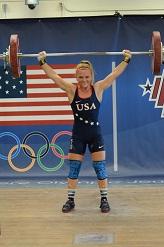
 Weightlifting is a sport people recognize, and to a certain extent, they understand how it works. They see it at the Olympics and they have seen people lifting at the gym. They might even do it themselves as part of a regular workout routine.
Weightlifting is a sport people recognize, and to a certain extent, they understand how it works. They see it at the Olympics and they have seen people lifting at the gym. They might even do it themselves as part of a regular workout routine.
People already understand that success in the sport involves strength and physical conditioning, as well as dedication and hard work. But there are also a number of trends in the sport that not everyone knows about or understands. USA Weightlifting, the national governing body of the sport, would like to help shed some light on some of those.
The Organization Itself
The Mission of USA Weightlifting is to enable United States athletes to achieve sustained competitive excellence in Olympic competition and to promote and grow the sport of weightlifting in the United States. How we do that, however, might come as a surprise to some people.
The Landscape of Sports and Fitness
Something we’re often asked these days is whether we see fitness competitions, as well as other strength and conditioning sports, as threats to weightlifting. I think in many cases, these sports are like us – we’re all working together toward the same goals, and one of those is to bring in new participants.
CrossFit is something other people often view as a threat to weightlifting, since it includes weightlifting as part of its competitions. Does weightlifting lose people to CrossFit? Yes, we do. In that respect, it represents a challenge to us. But the benefit is that we have people who do both sports at a very high level, and they motivate others and bring them into both sports. As a side note, CrossFit has made it more socially acceptable for women to lift weights – a great benefit we’re enjoying as well.
USA Powerlifting is another part of our landscape. We have actually produced one event in cooperation with them in the past, and we’ll be doing another in December. (For that matter, we’ve also done joint events with CrossFit.) It’s actually very exciting to work with the different groups. The message we all try to send is this: If you enjoy this sport – whether that’s weightlifting or powerlifting or CrossFit – you should try one of the others. You might like that too. Sometimes, people learn that although they’ve been training and participating in one, they’re naturally better at another. And really, it’s a win for us too – with all the cooperation, our club growth has been enormous.

Sometimes, people from outside the strength and conditioning sports tend to think that all athletes who become competitive weightlifters started out that way. That’s just not the case. We have a huge variety of athletes who come to our sport from different directions. In many cases, they were involved in other sports and they started cross-training with weights in order to gain strength and conditioning – and they just got hooked on it.
As an example, we have had many women come into the sport from a competitive cheerleading or gymnastics background. One of our last standouts at the international level had been a college soccer player. We have seen athletes move into weightlifting from wrestling, judo, football and track & field, as well. A lot of the larger athletes, speaking of track & field, went into weightlifting after participating in the throwing events, such as hammer or discus.
What you need in weightlifting is not just muscular development but flexibility and power. We’ve seen swimmers and triathletes come into weightlifting as a result of these abilities as well.
We’re seeing more women and more kids in the sport, but we’re also seeing more guys. Our age range is from seven all the way up to the eighties. Our Masters group is expanding as quickly as our senior group. In fact, the sport is growing everywhere, with more people attending and entering competitions.
Facilities Needed
Weightlifting is what is sometimes called a ‘box sport,’ meaning it requires a certain amount of open space – although this does not necessarily need to be a specialized facility. We generally use a convention center or a hotel, with at least 20,000 to 25,000 square feet of space, depending upon the level of competition. Spectator seating is also needed. We also need breakout space to go with the event, since there are ancillary events being held along with the competitions.
How We Travel
USA Weightlifting has a 63-foot truck that we bring to each event. It has all our platforms and the equipment we need. We can bring in everything and set up for the competition. In general, we expect at least 500 athletes for our events. Sometimes there are more, sometimes less, but in general, 500 is a good number. There will also be spectators, particularly at our Youth Nationals, which will be held in February of 2016 in Valley Forge, Pennsylvania. Our National Youth Championships, meanwhile, will be held in June of 2016 in Austin, Texas.
 The Perfect City
The Perfect City
Looking for the right place to host an event comes down to transportation. We need a city that has a major airport nearby, obviously. After that, we’re looking for a venue that is a realistic distance from the airport so that people can travel easily to the competition. We don’t want something miles and miles away; obviously, that’s going to be impossible for our athletes and their families to travel. We’re primarily focused on member satisfaction, and that takes precedence.
Our most successful events are in larger cities. We have used colleges as venues; since we look for sports cities, we can often find what we need there. We also look for volunteers who know something about the local weightlifting scene, and with local clubs for USA Weightlifting in all 50 states, they’re a good place to get those volunteers. We also have eight university clubs; these are found across the country. Our website contains downloadable information on how to host a weightlifting event, and on how to bid on our national events. We encourage people who are seeking information to check there and to get in touch with us. We welcome a conversation about it.
The Psychology of the Sport
Weightlifting is a self-sport, meaning that despite the fact that you can compete with others, you’re actually always looking to make your own form better, and to improve upon your own performance. When it is done correctly, weightlifting is a lifetime sport. It’s all about the time and the effort you put in. If you put more in, you’re going to get more out of it.
Success in the Sport
The U.S. has made huge strikes in weightlifting. Our women’s team recently won the gold medal in the Junior Pan Am Championships. In September, Randy Reid, a 61-year-old athlete, placed second in the Masters World Olympic Weightlifting Championships in Rovaniemi, Finland, a year after placing third at the same event in Denmark. He also won the Masters State Title in San Antonio in January. In April, he took second in the Masters National Championships and snagged his final domestic tournament of this year by winning gold in the Masters World Cup in August. And in September, 15-year-old C.J. Cummings won the gold medal in the 69-kilogram weight class at the Youth Pan American Games in San Luis Potosi, Mexico. Oh, and former cheerleader Megan Seegert, 16,won Youth Nationals in Minnesota, setting American youth and junior records in the snatch and clean and jerk.
In other words, weightlifting is big among U.S. athletes of all ages, and U.S. TV viewers can count on seeing many of our most promising stars in Rio. And when they do, it’s entirely possible that some of those viewers will sit up and become interested in the sport themselves.
The sport just keeps growing. It’s powered by athletes who come in from various disciplines and it’s fueled by cooperation with sports in the same family. We are focused on keeping our members satisfied and keeping that growth going.

